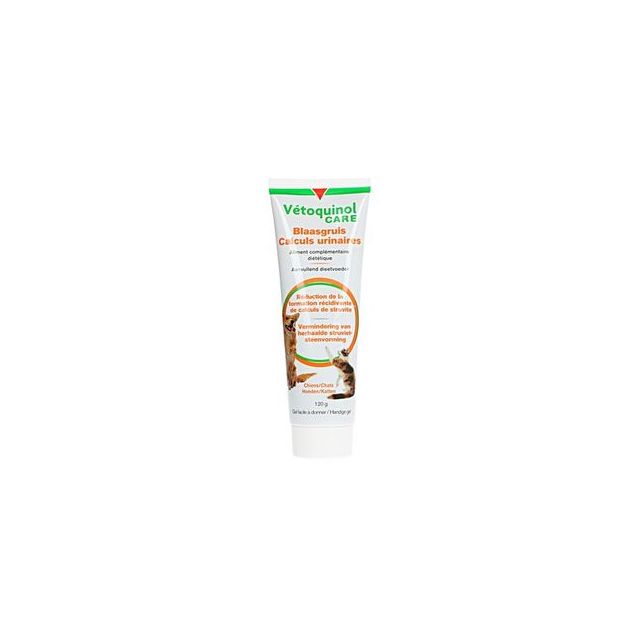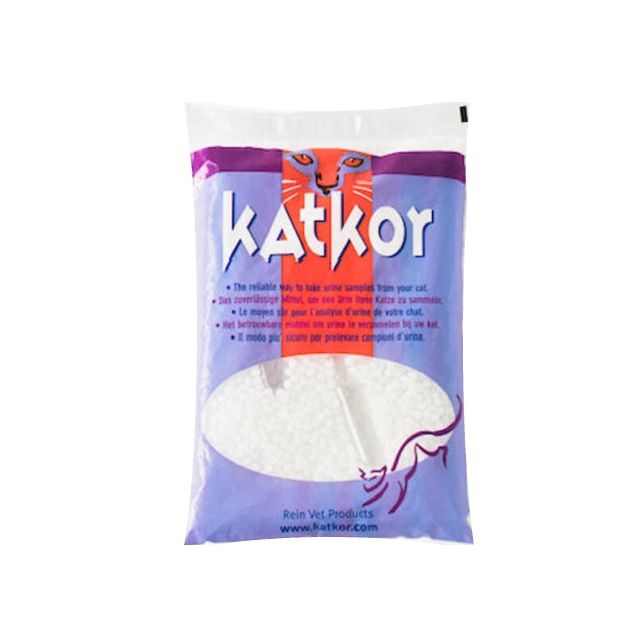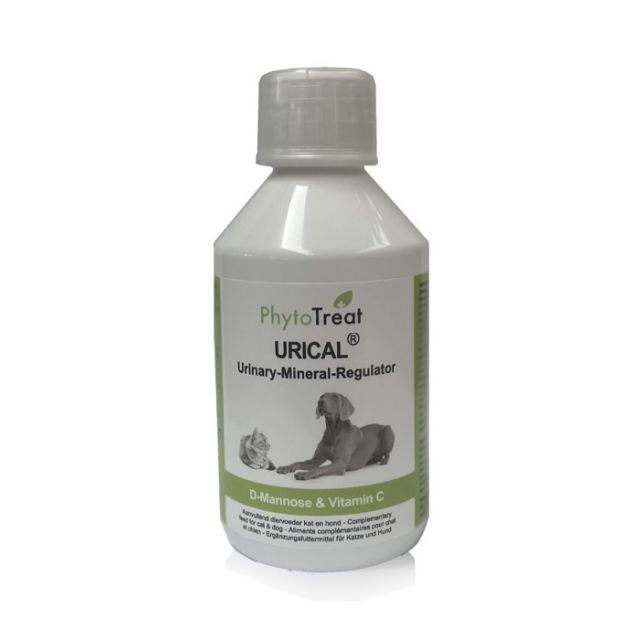Bladder stones in cats
Bladder grit is an important cause of bladder infection in cats. Bladder grit forms by the precipitation of minerals in the urine. If bladder grit remains in the bladder for a long time, it can clump together into bladder stones. By making a number of adjustments to the lifestyle and diet of your cat, you can keep the chance of problems with bladder grit as small as possible. Pharmacy4pets is happy to help you with this.
How does bladder grit form in cats?
Urine consists of fluid containing various minerals, which are excreted by the kidneys. If the urine is watery and does not contain an excess of minerals, these minerals dissolve neatly and your cat urinates them out. For various reasons, it may happen that the minerals do not dissolve and clump together as bladder grit or even as bladder stones. Factors playing a role include:
The concentration of the urine
In very watery urine, minerals dissolve more easily than in very concentrated urine. In the latter, the same amount of minerals is present in much less fluid. Compare a spoonful of sugar in a whole cup of tea or in just a little bit at the bottom. A cat gets concentrated urine by drinking little or by holding on for a long time. We often see this in overweight and lazy cats, but also if a cat does not want to or dare to go to the drinking or litter box because they are in a restless place, there is a chance of being 'jumped' on the way by another cat or small child, or simply because the box is found to be too dirty.
The amount of minerals in the urine
For various reasons, the proportion of specific minerals, such as calcium, magnesium, or ammonium, may increase. The more minerals present in the urine, the greater the chance that a part does not dissolve properly. If a cat receives much more food than recommended, it also takes in much more minerals. The excess is excreted through the urine by the kidneys. This is one of the reasons why we see bladder grit relatively often in overweight cats.
Also, some foods or food items contain a lot of a particular mineral, such as magnesium. This increases the chance of forming struvite, which is made up of magnesium ammonium phosphate. The cause can also lie in the cat's metabolism: in certain conditions (such as chronic kidney disease), a cat excretes more calcium in the urine than normal.
The acidity of the urine
The acidity, or the pH of the urine, varies throughout the day and also with the type of food the cat gets. Normally, this is a very nice balance, but for example, in a bacterial bladder infection, the pH often rises significantly for a longer period (the urine becomes less acidic).
In this alkaline urine, struvite is formed much faster. However, in very acidic urine, calcium oxalate and urates dissolve less well. Therefore, it is important to know the type of crystal before the acidity of the urine is influenced, and the effect must also be regularly checked.
The main types of bladder grit in cats
There are several types of crystals in cats, and some names have already been mentioned. The three most important crystals in cats are:
Struvite
Struvite, consisting of magnesium ammonium phosphate, was long the most common type of bladder stone in Dutch cats and is still the most well-known, especially as bladder grit. Struvite is more easily formed in an alkaline (thus not acidic) urine. In dogs, there is almost always a connection with a bacterial bladder infection, in cats this connection is much less frequent.
Struvite can be dissolved by giving a special diet.
Calcium Oxalate
Calcium oxalate is increasingly observed and has now ousted struvite from the first place as the most common type of bladder stone. This may be related to acidifying the urine too much to prevent struvite. Calcium oxalate can be formed at all pH levels, but most easily in very acidic urine. Diet foods that reduce the chance of struvite and calcium oxalate stones do not lower the pH to such an extent that the risk of calcium oxalate formation increases, while this can happen with other methods or less scientifically developed foods.
Vitamin C, advised in people with bladder infection to help acidify the urine, is a precursor of oxalate, the building block of calcium oxalate. Besides the fact that cats can produce vitamin C themselves and therefore do not need it, it does not help reduce the risk of bladder infection and increases the risk of calcium oxalate. So, do not give it! Unfortunately, calcium oxalates cannot be dissolved by adjusting the diet.
Urates
Urates occur much less frequently than struvite and calcium oxalate. They can arise from problems with the liver, but they also occur more frequently with a bacterial bladder infection. They are formed more readily in acidic urine.
Symptoms of bladder grit in cats
The symptoms of bladder grit are similar to the symptoms of a bladder infection with a different cause:
- Frequent visits to the litter box.
- Urinating small amounts frequently.
- Difficulty urinating: it takes a long time and involves a lot of digging in the box.
- Urinating is painful: meowing, hissing, or growling during urination.
- Urinating in the house.
- Blood in the urine.
- Washing frequently under the tail.
- Inability to urinate.
In a male cat, bladder grit can lead to a blockage of the urethra (urethral obstruction). A male cat that cannot urinate is also referred to as a "blocked cat." A blocked cat is always an emergency, so contact your veterinarian immediately if your male cat cannot urinate or only drips urine, even in the evening or on weekends. Inability to urinate has serious consequences for the bladder and kidneys; the cat can even die. The blockage must therefore be resolved as quickly as possible.
The diagnosis of bladder grit
To treat bladder grit in your cat as effectively as possible, it is important to know what type of grit it is. Urinalysis is essential in this regard. To collect urine from your cat, Katkor pellets in a clean and otherwise empty litter box are ideal. These pellets do not absorb moisture, allowing you to extract the urine with a pipette. Your veterinarian can also take urine through a bladder puncture in your cat. Since struvite can form quickly (within one and a half hours) in stored urine and calcium oxalate can spontaneously occur in very cold urine, having the veterinarian take the urine certainly has advantages for making the correct diagnosis. An ultrasound or X-ray can visualize the grit and determine if there are also bladder stones. If there are bladder stones that need to be surgically removed, these stones can be sent to a laboratory for analysis.
The treatment of bladder grit
Multiple factors play a role in the formation of bladder grit. Some of these factors can be influenced by dietary measures or lifestyle adjustments. Unfortunately, bladder grit often recurs once your cat has dealt with it. By taking a number of measures, you can significantly help reduce the chance of recurrence.
Medication for cats with bladder grit
To reduce pain and inflammation in cats with bladder infections, veterinarians often prescribe painkillers. Your cat may also benefit from supplements that promote healthy bladder mucosa, such as Feluro. Antibiotics are not routinely given because bacteria rarely cause bladder infections in cats. However, if a urine culture reveals a bacterial urinary tract infection, antibiotics are obviously indicated.
Nutrition for cats with bladder grit
Nutrition for cats with bladder grit, such as Sanimed Anti Struvite cat, among other things, ensures that the acidity (pH) of the urine is lowered and contains few building blocks for struvite and calcium oxalate, dissolving struvite and preventing the return of both struvite and calcium oxalate. This food can be given permanently. Stopping it greatly increases the chance that your cat will suffer from bladder grit again.
Small struvite stones can often be dissolved with diet and in those cases, surgery is not necessary. In the case of other or very large bladder stones, surgery may be required to remove the stones. The acidity of the urine can also be influenced by giving an acidifying paste such as Vetoquinol Care Bladder Grit Gel or Urical.
Note: When using diet food or dietary supplements that affect the urine pH such as Sanimed Anti Struvite Cat or Vetoquinol Care Bladder Grit Gel, it is extremely important to consult with the veterinarian before use. There are different types of bladder grit, each requiring a different approach. Acidifying the urine can sometimes have the opposite effect, especially if the type of grit (e.g., calcium oxalate or urate) is more easily formed in acidic urine!
Other measures for bladder grit
Stress plays an important role in the development of bladder infection and bladder grit, in part because anxious and nervous cats often drink poorly and hold their urine for a long time. Calming pheromones such as Feliway or the naturally soothing supplement Zylkene can help with this.
Drinking more is very important in treating and preventing bladder grit. This makes the urine less concentrated, allowing the minerals present to dissolve more easily. Place different types of water bowls in various quiet places and also try a drinking fountain, as many cats prefer running water. Wet food has a high moisture content, automatically allowing your cat to intake more water.
Holding urine for a long time, in addition to drinking little, is a significant factor in the formation of overly concentrated urine. Place enough litter boxes in quiet and secluded spots throughout the house and keep them clean daily. A good guideline is the number of cats plus one extra box. Experiment with types of cat litter to find out what your cat prefers. Some cats like a covered box, others prefer an open one. The box should always be spacious enough for the cat to comfortably assume the urinating position.
Bladder grit occurs significantly more often in overweight cats. Keep your cat slim and do not overfeed. Too much food automatically also means more minerals, the building blocks of bladder grit.
Treating bladder grit in cats can be quite a challenge. Fortunately, most cats manage to keep the symptoms under control, although recurrence of symptoms is common. We are happy to help you keep the risk of recurrence as small as possible. If you have any questions about our products or about bladder grit in your cat, please contact us.




